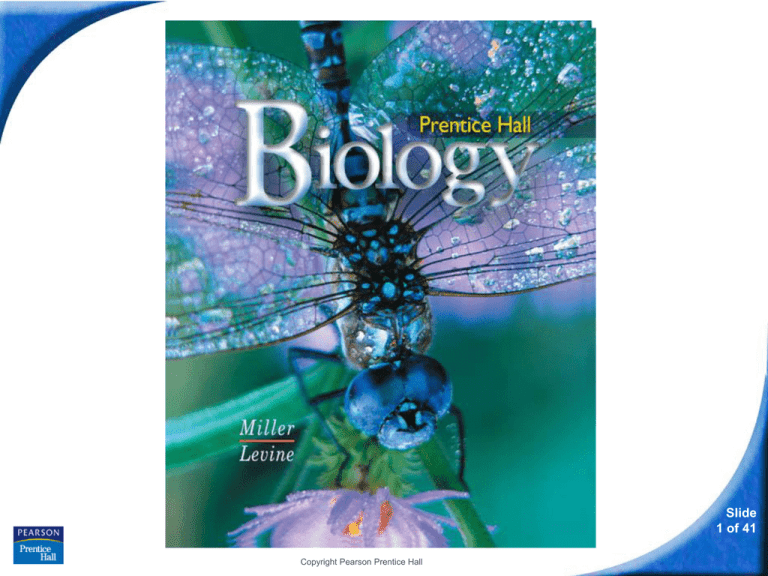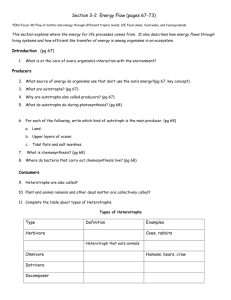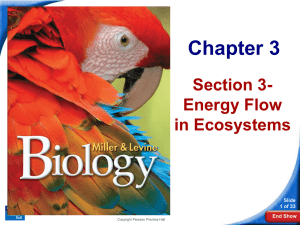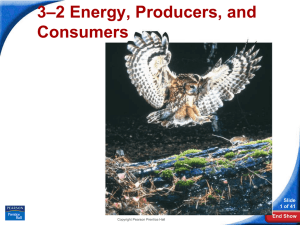
Biology
Slide
1 of 41
Copyright Pearson Prentice Hall
3–2 Energy Flow
Slide
2 of 41
Copyright Pearson Prentice Hall
3–2 Energy Flow
Producers
Where does the energy for life processes
come from?
Slide
3 of 41
Copyright Pearson Prentice Hall
3–2 Energy Flow
Producers
Producers
Without a constant input of energy, living
systems cannot function.
Sunlight is the main energy source for life
on Earth.
Slide
4 of 41
Copyright Pearson Prentice Hall
3–2 Energy Flow
Producers
In a few ecosystems, some organisms obtain
energy from a source other than sunlight.
Some types of organisms rely on the
energy stored in inorganic chemical
compounds.
Slide
5 of 41
Copyright Pearson Prentice Hall
3–2 Energy Flow
Producers
Only plants, some algae, and certain bacteria can
capture energy from sunlight or chemicals and use
that energy to produce food.
These organisms are called autotrophs.
Slide
6 of 41
Copyright Pearson Prentice Hall
3–2 Energy Flow
Producers
Autotrophs use energy from the environment to fuel
the assembly of simple inorganic compounds into
complex organic molecules.
These organic molecules combine and recombine to
produce living tissue.
Slide
7 of 41
Copyright Pearson Prentice Hall
3–2 Energy Flow
Producers
Because they make their own food, autotrophs are
called producers.
Slide
8 of 41
Copyright Pearson Prentice Hall
3–2 Energy Flow
Producers
Energy From the Sun
The best-known autotrophs harness solar energy
through a process known as photosynthesis.
During photosynthesis, these autotrophs use light
energy to convert carbon dioxide and water into
oxygen and energy-rich carbohydrates.
Slide
9 of 41
Copyright Pearson Prentice Hall
3–2 Energy Flow
Producers
Photosynthesis is
responsible for
adding oxygen to—
and removing carbon
dioxide from—Earth's
atmosphere.
Slide
10 of 41
Copyright Pearson Prentice Hall
3–2 Energy Flow
Producers
Plants are the main autotrophs on land.
Algae are the main autotrophs in freshwater
ecosystems and in the upper layers of the ocean.
Photosynthetic bacteria are important in certain wet
ecosystems such as tidal flats and salt marshes.
Slide
11 of 41
Copyright Pearson Prentice Hall
3–2 Energy Flow
Producers
Life Without Light
Some autotrophs can produce food in the absence
of light.
When organisms use chemical energy to produce
carbohydrates, the process is called
chemosynthesis.
Slide
12 of 41
Copyright Pearson Prentice Hall
3–2 Energy Flow
Producers
Slide
13 of 41
Copyright Pearson Prentice Hall
3–2 Energy Flow
Slide
14 of 41
Copyright Pearson Prentice Hall
3–2 Energy Flow
Producers
Chemosynthesis is performed by several types of
bacteria.
These bacteria represent a large proportion of living
autotrophs.
Slide
15 of 41
Copyright Pearson Prentice Hall
3–2 Energy Flow
Producers
Some chemosynthetic bacteria live in very remote
places on Earth, such as volcanic vents on the deepocean floor and hot springs.
Others live in more common places, such as tidal
marshes along the coast.
Slide
16 of 41
Copyright Pearson Prentice Hall
3–2 Energy Flow
Slide
17 of 41
Copyright Pearson Prentice Hall
3–2 Energy Flow
Consumers
Consumers
Many organisms cannot harness energy directly
from the physical environment.
Organisms that rely on other organisms for their
energy and food supply are called heterotrophs.
Heterotrophs are also called consumers.
Slide
18 of 41
Copyright Pearson Prentice Hall
3–2 Energy Flow
Consumers
There are many different types of heterotrophs.
• Herbivores eat plants.
• Carnivores eat animals.
• Omnivores eat both plants and animals.
• Detritivores feed on plant and animal remains
and other dead matter.
• Decomposers, like bacteria and fungi, break
down organic matter.
Slide
19 of 41
Copyright Pearson Prentice Hall
3–2 Energy Flow
Feeding Relationships
How does energy flow through living
systems?
Slide
20 of 41
Copyright Pearson Prentice Hall
3–2 Energy Flow
Feeding Relationships
Feeding Relationships
The relationships between producers and
consumers connect organisms into feeding
networks based on who eats whom.
Slide
21 of 41
Copyright Pearson Prentice Hall
3–2 Energy Flow
Feeding Relationships
Energy flows through an ecosystem in
one direction, from the sun or inorganic
compounds to autotrophs (producers)
and then to various heterotrophs
(consumers).
Slide
22 of 41
Copyright Pearson Prentice Hall
3–2 Energy Flow
Feeding Relationships
Food Chains
A food chain is a series of steps in which
organisms transfer energy by eating and being
eaten.
Slide
23 of 41
Copyright Pearson Prentice Hall
3–2 Energy Flow
Feeding Relationships
In some marine food chains, the producers are
microscopic algae and the top carnivore is four steps
removed from the producer.
Small Fish
Zooplankton
Squid
Shark
Algae
Slide
24 of 41
Copyright Pearson Prentice Hall
3–2 Energy Flow
Feeding Relationships
Food Webs
Ecologists describe a feeding relationship in an
ecosystem that forms a network of complex
interactions as a food web.
A food web links all the food chains in an
ecosystem together.
Slide
25 of 41
Copyright Pearson Prentice Hall
3–2 Energy Flow
Feeding Relationships
This food web
shows some of
the feeding
relationships in a
salt-marsh
community.
Slide
26 of 41
Copyright Pearson Prentice Hall
3–2 Energy Flow
Feeding Relationships
Trophic Levels
Each step in a food chain or food web is called a
trophic level.
Producers make up the first trophic level.
Consumers make up the second, third, or higher
trophic levels.
Each consumer depends on the trophic level below
it for energy.
Slide
27 of 41
Copyright Pearson Prentice Hall
3–2 Energy Flow
Ecological Pyramids
How efficient is the transfer of energy
among organisms in an ecosystem?
Slide
28 of 41
Copyright Pearson Prentice Hall
3–2 Energy Flow
Ecological Pyramids
Ecological Pyramids
The amount of energy or matter in an ecosystem
can be represented by an ecological pyramid.
An ecological pyramid is a diagram that shows
the relative amounts of energy or matter contained
within each trophic level in a food chain or food
web.
Slide
29 of 41
Copyright Pearson Prentice Hall
3–2 Energy Flow
Ecological Pyramids
Ecologists recognize three different types of
ecological pyramids:
• energy pyramids
• biomass pyramids
• pyramids of numbers
Slide
30 of 41
Copyright Pearson Prentice Hall
3–2 Energy Flow
Ecological Pyramids
0.1% Third-level
consumers
Energy Pyramid:
Shows the relative
amount of energy
available at each
trophic level.
1% Second-level
consumers
10% First-level
consumers
Only part of the
energy that is stored
in one trophic level is
passed on to the next
level.
100% Producers
Slide
31 of 41
Copyright Pearson Prentice Hall
3–2 Energy Flow
Ecological Pyramids
The more levels that exist between a
producer and a top-level consumer in an
ecosystem, the less energy that remains from
the original amount.
Only about 10 percent of the energy
available within one trophic level is
transferred to organisms at the next
trophic level.
Slide
32 of 41
Copyright Pearson Prentice Hall
3–2 Energy Flow
Ecological Pyramids
Biomass Pyramid
The total amount of living tissue within a given
trophic level is called biomass.
Biomass is usually expressed in terms of grams of
organic matter per unit area.
A biomass pyramid represents the amount of
potential food available for each trophic level in an
ecosystem.
Slide
33 of 41
Copyright Pearson Prentice Hall
3–2 Energy Flow
Ecological Pyramids
Biomass Pyramid:
Represents the amount of
living organic matter at each
trophic level. Typically, the
greatest biomass is at the base
of the pyramid.
50 grams of
human tissue
500 grams of
chicken
5000 grams
of grain
Slide
34 of 41
Copyright Pearson Prentice Hall
3–2 Energy Flow
Ecological Pyramids
Pyramid of Numbers
A pyramid of numbers shows the relative number
of individual organisms at each trophic level.
Slide
35 of 41
Copyright Pearson Prentice Hall
3–2 Energy Flow
Ecological Pyramids
Pyramid of
Numbers:
Shows the relative
number of individual
organisms at each
trophic level.
Slide
36 of 41
Copyright Pearson Prentice Hall
3–2 Energy Flow
Ecological Pyramids
For some ecosystems, the shape of the pyramid of
numbers is the same as that of the energy and
biomass pyramids.
However, in ecosystems where there are fewer
producers than there are consumers, such as a
forest ecosystem, the pyramid of numbers would not
resemble a typical pyramid at all.
Slide
37 of 41
Copyright Pearson Prentice Hall
3–2
Click to Launch:
Continue to:
- or -
Slide
38 of 41
Copyright Pearson Prentice Hall
3–2
The main source of energy for life on Earth is
a. organic chemical compounds.
b. inorganic chemical compounds.
c. sunlight.
d. producers.
Slide
39 of 41
Copyright Pearson Prentice Hall
3–2
Organisms that feed on plant and animal
remains and other dead matter are
a. detritivores.
b. carnivores.
c. herbivores.
d. autotrophs.
Slide
40 of 41
Copyright Pearson Prentice Hall
3–2
How does a food web differ from a food chain?
a. A food web contains a single series of
energy transfers.
b. A food web links many food chains together.
c. A food web has only one trophic level.
d. A food web shows how energy passes from
producer to consumer.
Slide
41 of 41
Copyright Pearson Prentice Hall
3–2
In a biomass pyramid, the base of the pyramid
represents the mass of
a. heterotrophs.
b. primary consumers.
c. producers.
d. top level carnivores.
Slide
42 of 41
Copyright Pearson Prentice Hall
3–2
The amount of energy represented in each
trophic level of consumers in an energy pyramid
is about
a. 10% of the level below it.
b. 90% of the level below it.
c. 10% more than the level below it.
d. 90% more than the level below it.
Slide
43 of 41
Copyright Pearson Prentice Hall
END OF SECTION








